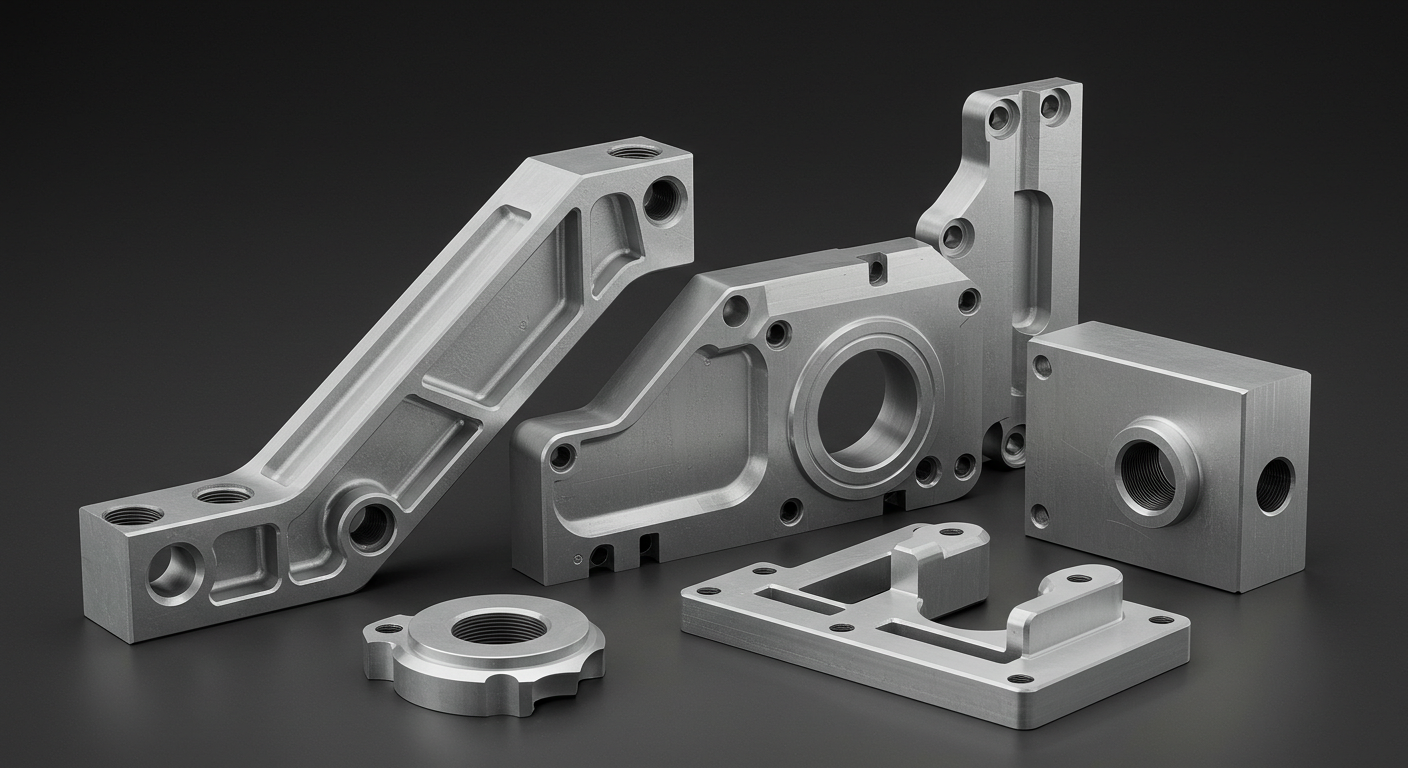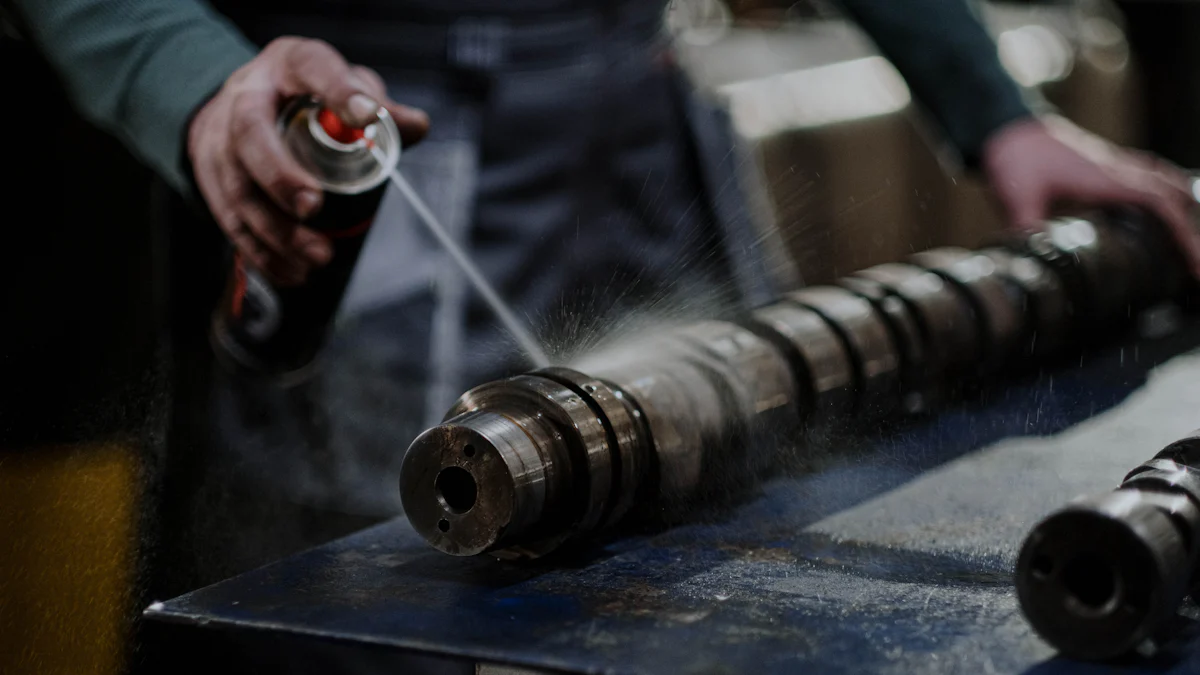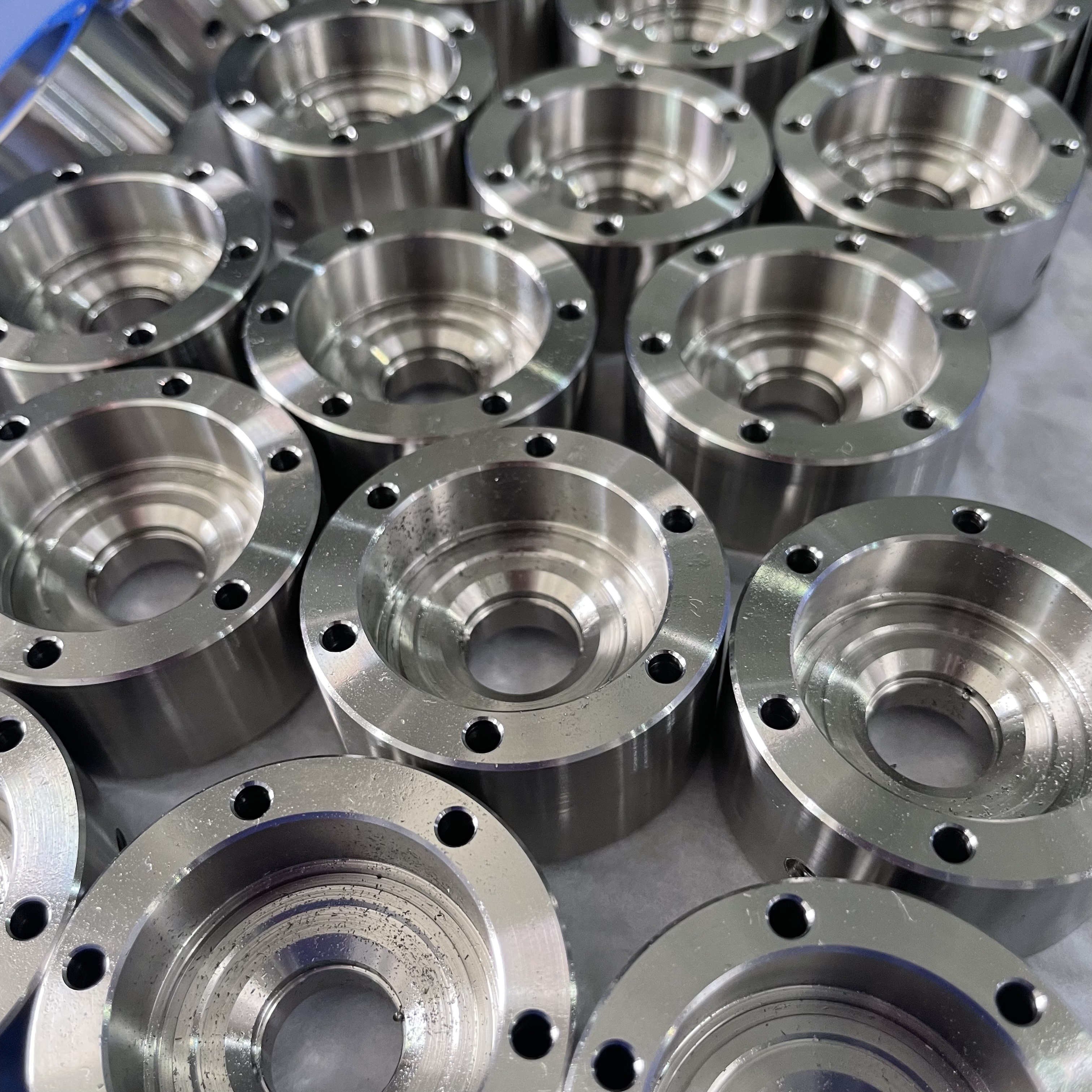Understanding the Cost Benefits of CNC Machining for Different Industries

Cost efficiency plays a vital role in modern manufacturing. You need solutions that reduce expenses while maintaining quality and precision. CNC machining stands out as a game-changer in this regard. Unlike traditional methods, CNC offers faster production speeds, minimal material waste, and lower setup costs.
Manufacturing Method | Setup Cost | Production Speed | Material Waste | Labor Cost | Ideal Use Case |
|---|---|---|---|---|---|
CNC Machining | Low | Fast | Minimal | Moderate | High-precision parts, small to medium runs |
Traditional Machining | High | Slow | High | High | Low-precision, low-volume parts |
This comparison highlights why industries increasingly rely on CNC machining for its unmatched efficiency. But what makes CNC machining such a cost-effective solution for diverse applications?
Key Takeaways
CNC machining saves money by working faster and wasting less material. It’s great for making precise parts.
Picking the right materials can cut costs a lot. Use easy-to-machine materials like aluminum to spend less.
Simple designs take less time and cost less to make. Stick to what’s needed without adding extra details.
Making more parts lowers the cost of each one. Share fixed costs over many parts to save more.
Working with a trusted manufacturer helps save money. Talk early and share ideas during the design process.
Key Factors Influencing CNC Machining Cost
Understanding the factors influencing CNC machining costs can help you make informed decisions and optimize your manufacturing process. Let’s explore three critical aspects: material selection, machining time, and design complexity.
Material Selection
The materials you choose play a significant role in determining CNC machining costs. Raw material costs vary widely. For example, aluminum is more affordable than titanium or copper. However, the ease of machining these materials also impacts expenses. While aluminum is cheaper, its machining challenges can increase costs. Harder materials like titanium require specialized tools and longer machining times, which further raise expenses.
Recyclability is another factor to consider. Materials that are easy to recycle, such as certain metals, can offset future raw material costs. By carefully selecting materials, you can balance affordability and performance, ensuring efficiency in your CNC machining projects.
Machining Time
Machining time directly affects production costs. Longer machining times mean higher operating expenses, as machines run for extended periods. Complex parts often require advanced machinery and additional setup, which increases costs. Even minor design changes can lead to higher expenses due to the need for new cutting tools and adjustments in the CAD design process.
To reduce machining time, focus on simplifying your designs and selecting materials that are easier to machine. This approach not only saves time but also lowers overall costs.
Design Complexity
The complexity of your design significantly influences CNC machining costs. Intricate features, such as deep cavities or sharp edges, require advanced milling machines and longer machining times. These designs often demand more expensive tooling and additional setup, which increases costs.
Simplifying your design can help reduce expenses. Avoid unnecessary complexities and focus on creating parts that meet functional requirements without excessive detail. This strategy minimizes machining time and material waste, improving overall cost efficiency.
Volume and Scalability
Production volume plays a critical role in determining CNC machining costs. When you increase the number of units produced, fixed costs like setup and tooling are spread across a larger quantity. This distribution significantly reduces the cost per unit, making high-volume production a cost-effective choice. For instance, if you produce thousands of identical parts, the setup time becomes negligible on a per-unit basis. Bulk material purchases also lead to discounts, further lowering expenses.
Production Volume | Cost Implications | Strategies to Optimize |
|---|---|---|
High Volume | Lower per-unit cost due to distributed setup expenses; bulk material purchases lead to discounts; efficient machine utilization. | Invest in high-capacity CNC machines; standardize designs; automate processes. |
Medium Volume | Moderate per-unit cost; some benefits from economies of scale. | Use versatile machines; combine orders. |
Low Volume | High per-unit cost due to fixed setup expenses; inefficient utilization. | Simplify designs; use standard tooling. |
Prototype/One-Off Orders | Very high per-unit cost; custom tooling required. | Use 3D printing for prototypes; choose flexible machines. |
Scalability is another advantage of CNC machining. Whether you need a single prototype or thousands of units, CNC systems adapt to your requirements. For low-volume production, you can focus on simplifying designs and using standard tooling to minimize costs. On the other hand, high-volume production benefits from automation and standardized processes, which maximize efficiency and reduce machining time.
CNC machining also allows you to scale production without compromising quality. Advanced CNC machines maintain precision and accuracy, even during long production runs. This consistency ensures that every part meets your specifications, regardless of volume. By leveraging the scalability of CNC, you can optimize costs while meeting your production goals.
Understanding how volume impacts costs helps you make informed decisions. Whether you’re producing a single prototype or scaling up for mass production, CNC machining offers the flexibility to meet your needs efficiently. This adaptability makes it a valuable solution across industries.
CNC Machining Costs Across Industries

Aerospace Industry
CNC machining plays a critical role in the aerospace industry, where precision and reliability are paramount. However, the costs associated with CNC machining in this sector can vary significantly. Several factors influence these costs:
Material selection is crucial. Aerospace components often require high-performance materials like titanium or aluminum, which can be expensive. Titanium, for example, is harder to machine, increasing machining time and costs.
The complexity of part designs also impacts costs. Intricate geometries or tight tolerances demand advanced CNC machines and longer machining times.
Larger parts require more resources, further driving up costs.
Hourly rates for CNC machining in aerospace typically range from $20 to $50, depending on the machine type. Per-part costs can vary from $10 to over $160, influenced by material choice and design intricacy. Despite these costs, CNC machining ensures the production of high-quality, reliable components essential for aerospace applications.
Automotive Industry
In the automotive industry, CNC machining offers significant cost efficiency. This sector benefits from CNC's ability to produce high-precision parts at scale. Key contributions to cost savings include:
Aspect | Contribution to Cost Efficiency |
|---|---|
Reduced Waste | CNC machining minimizes material waste, saving costs, especially with expensive materials. |
Lower Labor Costs | CNC machines operate with minimal supervision, reducing labor expenses. |
Flexibility in Production | CNC machines adapt quickly to different tasks, minimizing downtime and changeover costs. |
Enhanced Precision and Quality | High precision reduces errors and defects, lowering rework costs and improving part reliability. |
Scalability | CNC machining becomes more cost-effective at higher production volumes, decreasing unit costs. |
CNC machining enables automotive manufacturers to produce durable, high-quality parts while keeping costs under control. Its scalability ensures that both low-volume and mass production runs remain efficient.
Medical Industry
The medical industry relies on CNC machining for its ability to produce intricate, high-precision components. However, CNC machining costs in this sector depend on several factors. Materials like metals are often more expensive than plastics, and the complexity of part designs, including tight tolerances, increases machining time and costs.
To reduce costs, you can optimize material selection by choosing cost-effective and machinable options like aluminum or certain plastics. Simplifying part designs also minimizes machining steps and tool changes. Additionally, producing larger quantities lowers costs per unit by spreading setup and tooling expenses across the production run.
CNC machining ensures the production of reliable, high-quality medical components, making it an indispensable solution for this industry. Its ability to meet stringent design and tolerance requirements justifies the investment, especially for life-critical applications.
Electronics Industry
CNC machining has revolutionized the electronics industry by offering cost-effective solutions for producing high-precision components. You can rely on CNC to manufacture intricate parts like circuit boards, heat sinks, and enclosures with unmatched accuracy. This precision ensures that every part meets the tight tolerances required for electronic devices.
Several factors make CNC machining a cost-efficient choice in electronics production:
CNC automation minimizes production errors, helping you avoid costly mistakes during manufacturing.
Rapid prototyping capabilities allow you to identify design flaws early, saving money when scaling to mass production.
The ability to produce more with less waste contributes to overall cost efficiency.
CNC machining enhances efficiency in production processes. It reduces material waste by cutting only what is necessary, which is especially important when working with expensive materials like copper or aluminum. High precision ensures that CNC machined parts meet quality standards, reducing the need for rework or replacements.
You can also benefit from CNC's scalability. Whether you need a small batch of prototypes or large-scale production, CNC adapts to your requirements. This flexibility allows you to optimize costs while maintaining consistent quality. Additionally, CNC machining supports the creation of complex designs, enabling innovation in electronic devices without driving up expenses.
By leveraging CNC machining, you can achieve cost savings while producing reliable, high-quality electronic components. This makes CNC an indispensable tool in the fast-paced electronics industry, where precision and efficiency are critical.
Cost-Saving Advantages of CNC Machining
Precision and Accuracy
CNC machining delivers unmatched precision and accuracy, which directly translates into cost savings for your business. These machines can produce complex shapes and designs with ease, ensuring consistent quality across all parts. Unlike traditional methods, CNC systems operate independently of operator skill, reducing the likelihood of human error. This consistency minimizes the need for rework or scrap, saving both time and resources.
You can also rely on CNC machines to run continuously, producing high-precision parts with minimal supervision. This reduces labor costs while maintaining exceptional quality. By investing in CNC machining, you ensure that every part meets your specifications, eliminating the expenses associated with defective products.
Reduced Material Waste
CNC machining is known for its efficiency in material usage. These machines cut only what is necessary, significantly reducing waste compared to traditional methods. This not only lowers material costs but also supports sustainable manufacturing practices. Innovations in CNC technology further enhance this efficiency, allowing you to maximize the use of raw materials.
For example, CNC systems are highly efficient when working with expensive materials like titanium or copper. By minimizing scrap rates, you save money and reduce the environmental impact of your operations. This makes CNC machining an ideal choice for businesses looking to balance cost efficiency with sustainability.
Scalability and Flexibility
CNC machining offers unparalleled scalability and flexibility, making it a cost-effective solution for businesses of all sizes. Whether you need a small prototype run or large-scale production, CNC systems adapt to your requirements. This flexibility allows you to manage inventory efficiently, reducing the need for excess stock and associated costs.
Outsourcing CNC machining further enhances scalability. You can quickly adjust production volumes based on market demand without significant internal changes. This is particularly beneficial for businesses experiencing fluctuating needs. By leveraging economies of scale, you reduce per-unit costs while maintaining consistent quality. As your business grows, CNC machining ensures seamless scaling, aligning with your expansion goals.
Long-Term Savings
Investing in CNC machining offers substantial long-term savings for your business. While the initial setup costs may seem high, the benefits you gain over time far outweigh the upfront expenses. CNC machines operate continuously with minimal human intervention. This reduces labor costs significantly, as fewer operators are needed to oversee production. By automating the manufacturing process, you also minimize human error, saving time and resources.
The precision and accuracy of CNC machining eliminate the need for costly rework or scrap. Every part meets exact specifications, ensuring consistent quality. This reliability reduces waste and lowers production costs. Additionally, CNC systems use a variety of cutting tools, which increases flexibility and reduces tooling expenses. You can switch between different designs or materials without incurring extra costs for new tools.
CNC machining also optimizes material usage. Advanced cutting paths minimize waste, saving money and promoting sustainable practices. This efficiency is especially valuable when working with expensive materials like titanium or copper. Over time, the reduction in material waste contributes to significant cost savings.
Faster production times are another advantage. CNC machines complete tasks quickly, improving your time-to-market. This speed allows you to meet customer demands faster, increasing revenue and profitability. For larger production volumes, the cost per unit decreases as setup expenses are distributed across more parts. This scalability ensures that CNC machining remains cost-effective as your business grows.
By investing in CNC technology, you secure a manufacturing process that delivers efficiency, precision, and sustainability. These factors combine to provide long-term savings, making CNC machining a smart choice for businesses aiming to reduce costs while maintaining high-quality production.
Tips to Reduce CNC Machining Costs
Material Selection
Choosing the right materials is one of the most effective ways to reduce cnc machining costs. Materials with high machinability, such as aluminum, can lower tool wear and machining time. This makes them a cost-effective choice for many projects. For example, aluminum is often preferred for prototypes due to its quick processing times and favorable properties.
When selecting materials, consider your project’s requirements. Factors like mechanical strength, thermal properties, and recyclability can influence costs. Avoid materials that exceed your project’s needs, as they may lead to unnecessary expenses. Additionally, material availability plays a role. Opt for readily available materials to avoid price fluctuations caused by market demand.
Larger production volumes can also reduce costs. Bulk purchasing of materials often leads to discounts, making it easier to manage expenses. By carefully evaluating your material options, you can balance performance and affordability while minimizing waste.
Design Optimization
Optimizing your design is another key strategy to reduce cnc machining costs. Simplifying geometries can significantly lower machining time and expenses. For instance, rounded internal corners and shallow pockets are easier to machine than sharp edges or deep cavities.
Using standardized components can also save on material costs and reduce setup time. When possible, specify looser tolerances to avoid unnecessary precision. This approach ensures that your design meets functional requirements without driving up costs.
Additionally, consider the number of machining processes required. Streamlining these processes can minimize setup time and tooling expenses. Clear markings and optimized geometric features further simplify machining, reducing run times. By focusing on design for manufacturing principles, you can create cost-efficient parts without compromising quality.
Partnering with the Right Manufacturer
Collaborating with the right manufacturer can help you reduce cnc machining costs. A reliable partner with robust quality assurance processes ensures consistent results, minimizing the risk of defects or rework.
Effective communication is essential. Choose a manufacturer willing to collaborate closely and provide cost-saving insights during the design phase. Early supplier involvement can help you identify opportunities to optimize materials and machining processes.
Transparent pricing and flexible contract terms are also important. Look for a manufacturer who can adapt to your changing production needs. Access to advanced technology and skilled operators further enhances efficiency, reducing labor and tooling costs. By selecting the right partner, you can streamline your operations and achieve long-term savings.
Leveraging Technology
Leveraging advanced technology in CNC machining can significantly reduce costs while improving efficiency. Modern CNC systems incorporate cutting-edge features that streamline production processes and optimize resource usage. By adopting these technologies, you can enhance your manufacturing operations and achieve substantial savings.
One way to reduce costs is by simplifying part designs. Advanced software tools allow you to create designs that minimize machining time and complexity. For example, rounded edges and standardized components are easier to machine, reducing the need for custom tooling. This approach not only saves time but also lowers expenses associated with tool wear and maintenance.
Efficient tooling strategies further enhance cost savings. Modern CNC machines use optimized tool paths to minimize machining time. These strategies ensure that tools perform efficiently, reducing wear and extending their lifespan. You can also select cost-effective materials that align with your project’s functional requirements. Materials with high machinability, such as aluminum, are easier to process and reduce overall costs.
Early supplier involvement is another way to leverage technology for cost savings. Collaborating with your CNC machining partner during the design phase helps identify opportunities to optimize materials and processes. This proactive approach ensures that your designs are both functional and cost-efficient.
Automation plays a crucial role in modern machining. CNC systems equipped with automation features can run continuously with minimal supervision. This reduces labor costs and increases production speed. Additionally, automated quality checks ensure that every part meets your specifications, eliminating the need for rework or scrap.
By embracing advanced CNC machining technology, you can streamline your operations, reduce waste, and lower production costs. These innovations make CNC machining a powerful tool for achieving efficiency and maintaining high-quality standards.
Understanding the factors influencing CNC machining costs helps you make smarter decisions. Key cost factors include materials, machining time, design complexity, and production volume. By focusing on these, you can optimize your processes and reduce expenses. CNC machining offers clear advantages, such as precision, reduced waste, and scalability. These benefits lower labor, material, and production costs while ensuring high-quality cnc machined parts.
To save more, choose machinable materials, simplify designs, and partner with reliable cnc machining services. Leveraging advanced technology also minimizes machining time and boosts efficiency. Explore CNC machining as a cost-effective solution to meet your manufacturing needs while maintaining quality and affordability.
FAQ
What is CNC machining, and why is it cost-effective?
CNC machining uses computer-controlled tools to create precise parts. It reduces material waste, minimizes errors, and operates efficiently. These factors lower production costs while maintaining high-quality standards. You can rely on CNC machining for both small and large-scale manufacturing needs.
How does CNC machining reduce material waste?
CNC machines cut only the required material, leaving minimal scrap. Advanced software optimizes cutting paths, ensuring efficient material usage. This precision saves money, especially when working with expensive materials like titanium or copper. You also benefit from sustainable manufacturing practices.
Can CNC machining handle complex designs?
Yes, CNC machining excels at producing intricate designs. Advanced machines and software allow you to create parts with tight tolerances and complex geometries. This capability ensures that even the most detailed designs meet your specifications without compromising quality or increasing costs significantly.
Is CNC machining suitable for low-volume production?
CNC machining adapts well to low-volume production. You can produce prototypes or small batches without high setup costs. Simplifying designs and using standard tooling further reduces expenses. This flexibility makes CNC machining an excellent choice for custom or one-off projects.
How can I choose the right material for CNC machining?
Select materials based on your project’s requirements. Consider machinability, strength, and cost. Aluminum works well for prototypes due to its affordability and ease of machining. For durability, choose titanium or steel. Always balance performance with cost to optimize your manufacturing process.
Tip: Consult your CNC machining partner for material recommendations tailored to your project.
See Also
Discovering Seven Major Advantages of CNC Machining Techniques
Comparing CNC and Traditional Manufacturing Across Various Sectors
Investigating CNC Machining Solutions for Accurate Manufacturing Needs
Streamlined CNC Machining Services for High-Precision Production
Grasping CNC Machining Fundamentals for Component and Part Production
About US
Follow Us
Your prototype holds unparalleled significance, and we deeply value its uniqueness. Collaborating with you during the preparation phase for running your prototype or parts is a commitment we gladly embrace. Whether it's a single part or a complex assembly, we are dedicated to selecting the optimal tools and pathways to bring your envisioned product to life.
At Precision Fab CNC Machining, we specialize in producing parts for prototypes, short runs, and high-volume production. Our prototyping machine capabilities extend across metal, plastic, and wood machining, with welding fabrication services available to complement and finalize your prototype if required.
Address
Address: Room320 10F, Building A,Nanshan international building, Dayawan District, Huizhou, Guangdong, 516001 China
Contacts
billy@timaycnc.com

